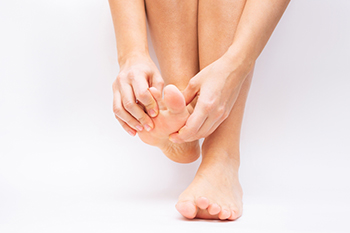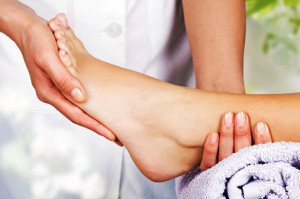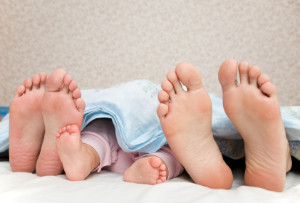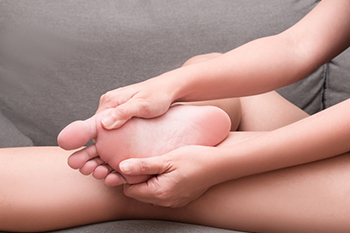Items filtered by date: August 2022
Arthritis Can Cause Pain in the Feet and Ankles
How Does the Big Toe Function?

To many people, the toes might seem like small and insignificant parts of the human body. Nothing could be further from the truth. Although the toes are small, the function that they serve, not just for the feet but for the entire body, is monumental. The big toe, for instance, has an interesting biomechanical structure that benefits other parts of the body. Also known as the hallux, the big toe helps grip the ground to provide leverage during motion activities like walking and running. Additionally, the big toe helps the feet balance when an individual puts weight on their feet. Ultimately, the big toe is what helps keep an individual from falling anytime that they stand or engage in motion activities. Without the big toe, the foot would essentially have to relearn how to balance. This would force other parts of the foot to take on the balancing function that the big toe usually has. The big toe can be susceptible to a multitude of different afflictions and foot conditions, including gout, ingrown toenails, and sesamoiditis. It is therefore critical that one takes extra care of this body part to keep it from falling prey to any of these afflictions. If you want to learn more about the function of the big toe, contact a podiatrist.
If you have any concerns about your feet, contact one of our podiatrists from Ultimate Foot Care . Our doctors can provide the care you need to keep you pain-free and on your feet.
Biomechanics in Podiatry
Podiatric biomechanics is a particular sector of specialty podiatry with licensed practitioners who are trained to diagnose and treat conditions affecting the foot, ankle and lower leg. Biomechanics deals with the forces that act against the body, causing an interference with the biological structures. It focuses on the movement of the ankle, the foot and the forces that interact with them.
A History of Biomechanics
- Biomechanics dates back to the BC era in Egypt where evidence of professional foot care has been recorded.
- In 1974, biomechanics gained a higher profile from the studies of Merton Root, who claimed that by changing or controlling the forces between the ankle and the foot, corrections or conditions could be implemented to gain strength and coordination in the area.
Modern technological improvements are based on past theories and therapeutic processes that provide a better understanding of podiatric concepts for biomechanics. Computers can provide accurate information about the forces and patterns of the feet and lower legs.
Understanding biomechanics of the feet can help improve and eliminate pain, stopping further stress to the foot.
If you have any questions please feel free to contact our office located in Smithtown, NY . We offer the newest diagnostic and treatment technologies for all your foot and ankle needs.
Two Types of Foot Therapy

Foot massages are a common form of relaxation, and many people choose this type of foot therapy to find relief from aching feet. It may come from standing all day or from wearing shoes that do not fit correctly. An additional method of therapy is reflexology and there are differences between the two. Reflexology is practiced by applying pressure to specific areas of the foot which can stimulate the central nervous system and can positively affect energy pathways. Different organs in the body are linked to pressure points on the feet and may have healing effects. Getting a foot massage involves massaging the entire foot without centering on certain areas. Some of the health benefits from either form of foot therapy can consist of improved circulation, relaxation, stress relief, and reduced muscle tension. Some patients find relief from headaches and back pain and can enjoy an overall sense of well-being. If you are interested in learning more about the benefits of different types of foot therapy, it is suggested that you consult with a podiatrist who can answer any questions you may have.
Foot therapy is often necessary for those recovering from either foot deformities or foot injuries. If you have concerns regarding therapy, consult with one of our podiatrists from Ultimate Foot Care . Our doctors can provide the care you need to keep you pain-free and on your feet.
Most Common Injuries
People who are active or athletes are prone to a variety of injuries. Therefore, it is often important to take part in physical therapy in order to quickly get back on the right track.
What to Do When Injured
Physical Therapy – This specialized treatment will focus on the affected area, speeding up recovery and the overall healing process. It is a proven method that has helped millions of people return from any injury.
During physical therapy you will undergo regimented training to get back into full form. Training is often very difficult, especially at first when the foot feels weak. Physical therapy often involves:
Basic stretching and twisting exercises – getting the feet’s mobility and flexibility up.
Massaging – the therapist will massage the injured area in order to activate the muscles and relax them.
Strengthening Exercises – this allows the muscles in the affected area to regain their full strength, a vital step towards full recovery.
If you have any questions please feel free to contact our office located in Smithtown, NY . We offer the newest diagnostic tools and technology to treat your foot and ankle needs.
Falling Can Lead to an Ankle Sprain

A common injury many people incur is called an ankle sprain. It is defined as a musculoskeletal injury that partially or fully tears the ligaments as a result of a sudden mishap. The ankle can severely twist by unexpectedly stepping off a curb or walking on an uneven surface. There may be a popping noise that happens at the time of the sprain and prompt medical attention is often needed. Additional symptoms can include swelling or bruising to the affected area, and it may be difficult to walk. Treatment often begins with elevating the sprained ankle as this can help to reduce swelling. The ankle may also feel better when it is wrapped with a compression bandage and crutches may be recommended that can help with completing daily activities. As the foot heals, there are specific stretches that can be practiced that can strengthen the ankle. If you have twisted your ankle or suspect it might be sprained, please confer with a podiatrist who can help you with effective treatment options.
Ankle sprains are common but need immediate attention. If you need your feet checked, contact one of our podiatrists from Ultimate Foot Care . Our doctors can provide the care you need to keep you pain-free and on your feet.
How Does an Ankle Sprain Occur?
Ankle sprains take place when the ligaments in your ankle are torn or stretched beyond their limits. There are multiple ways that the ankle can become injured, including twisting or rolling over onto your ankle, putting undue stress on it, or causing trauma to the ankle itself.
What Are the Symptoms?
- Mild to moderate bruising
- Limited mobility
- Swelling
- Discoloration of the skin (depending on severity)
Preventing a Sprain
- Wearing appropriate shoes for the occasion
- Stretching before exercises and sports
- Knowing your limits
Treatment of a Sprain
Treatment of a sprain depends on the severity. Many times, people are told to rest and remain off their feet completely, while others are given an air cast. If the sprain is very severe, surgery may be required.
If you have suffered an ankle sprain previously, you may want to consider additional support such as a brace and regular exercises to strengthen the ankle.
If you have any questions please feel free to contact our office located in Smithtown, NY . We offer the newest diagnostic and treatment technologies for all your foot and ankle needs.
How to Care For Children’s Feet

If you care for your children’s feet as they grow, this can help protect them from having problems with their feet as adults. Practicing a regular routine when it comes to caring for children’s feet is similar to what is recommended for adults. Wash your child’s feet every day, dry them carefully, and apply a bit of baby powder to keep them healthy. Buy them shoes that fit right – whether they are at the soft or hard shoe stage. Make sure that the shoes have enough room in the foot box for the toes to grow. Use socks made of cotton or wool and that fit properly without pinching your child’s feet. Cut their toenails in a straight line so that they do not develop ingrown toenails. Allow your children to go barefoot around the house so that their feet will develop and gain strength without being restricted. If questions or problems arise related to your children’s feet, consult with a podiatrist, an expert in this area.
The health of a child’s feet is vital to their overall well-being. If you have any questions regarding foot health, contact one of our podiatrists of Ultimate Foot Care . Our doctors can provide the care you need to keep you pain-free and on your feet.
Tips for Keeping Children's Feet Healthy
- Make sure their shoes fit properly
- Look for any signs of in-toeing or out-toeing
- Check to see if they have Clubfoot (condition that affects your child’s foot and ankle, twisting the heel and toes inward) which is one of the most common nonmajor birth defects.
- Lightly cover your baby’s feet (Tight covers may keep your baby from moving their feet freely, and could prevent normal development)
- Allow your toddler to go shoeless (Shoes can be restricting for a young child’s foot)
- Cut toenails straight across to avoid ingrown toenails
- Keep your child’s foot clean and dry
- Cover cuts and scrapes. Wash any scratches with soap and water and cover them with a bandage until they’ve healed.
If you have any questions, please feel free to contact our office located in Smithtown, NY . We offer the newest diagnostic and treatment technologies for all your foot care needs.
Symptoms of Sesamoiditis

There are many bones in your feet, and they each play an important role in helping your feet move and function. When important bones break or become inflamed, this can result in complications that might be painful or uncomfortable. For example, under your big toe are two sesamoid bones near the bottom of your feet. These bones can become inflamed from an injury or from tension that might occur if your big toe is suddenly and forcefully pushed upward. There are many different symptoms that can be felt from sesamoiditis. The most common symptom is pain. When putting pressure on the feet during walking or other physical activities, it is common for individuals with sesamoiditis to experience pain. However, what may make sesamoiditis difficult for the average person to identify is that there are not usually any noticeable, visual symptoms. That is to say that an individual might experience pain but not be able to point to any visual signs of sesamoiditis on their feet. To diagnose sesamoiditis, a medical professional can perform a bone scan or an MRI to identify the condition. If you are experiencing pain and inflammation in your sesamoid bones, contact a podiatrist who can help you treat the problem.
Sesamoiditis is an unpleasant foot condition characterized by pain in the balls of the feet. If you think you’re struggling with sesamoiditis, contact one of our podiatrists of Ultimate Foot Care . Our doctors will treat your condition thoroughly and effectively.
Sesamoiditis
Sesamoiditis is a condition of the foot that affects the ball of the foot. It is more common in younger people than it is in older people. It can also occur with people who have begun a new exercise program, since their bodies are adjusting to the new physical regimen. Pain may also be caused by the inflammation of tendons surrounding the bones. It is important to seek treatment in its early stages because if you ignore the pain, this condition can lead to more serious problems such as severe irritation and bone fractures.
Causes of Sesamoiditis
- Sudden increase in activity
- Increase in physically strenuous movement without a proper warm up or build up
- Foot structure: those who have smaller, bonier feet or those with a high arch may be more susceptible
Treatment for sesamoiditis is non-invasive and simple. Doctors may recommend a strict rest period where the patient forgoes most physical activity. This will help give the patient time to heal their feet through limited activity. For serious cases, it is best to speak with your doctor to determine a treatment option that will help your specific needs.
If you have any questions please feel free to contact our office located in Smithtown, NY . We offer the newest diagnostic and treatment technologies for all your foot and ankle needs.









